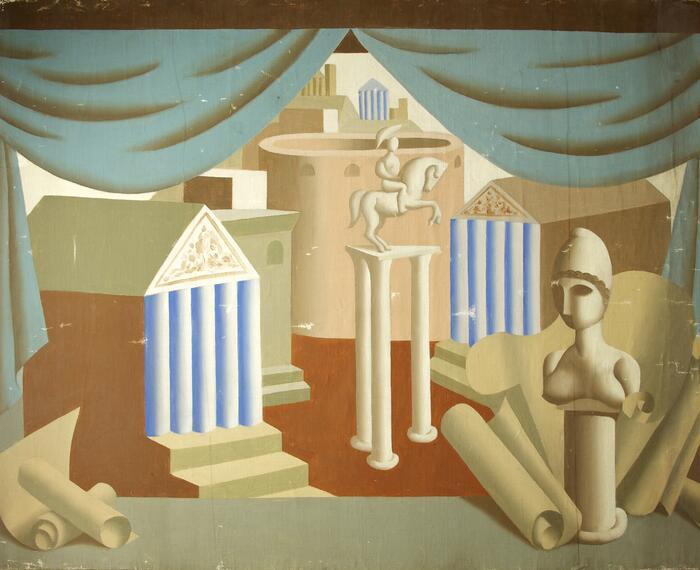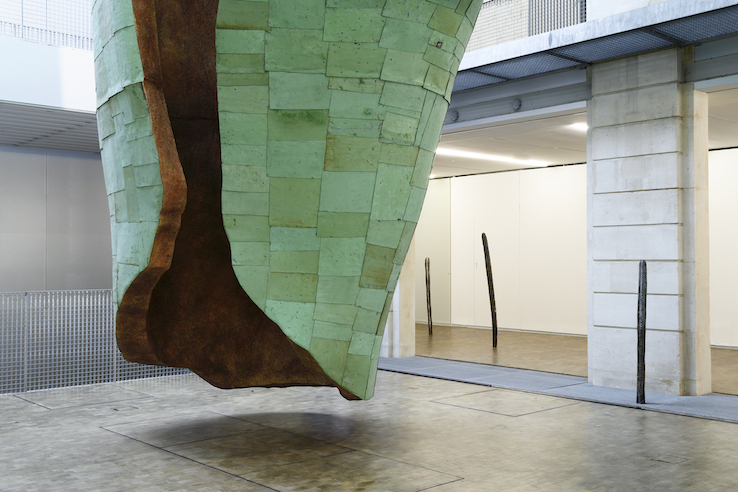


Katinka Bock, Rauschen, 2019. Courtesy de l’artiste et de Jocelyn Wolff, Paris, Meyer Riegger, Karlsruhe/Berlin et Great Meert, Bruxelles. Work produced by Lafayette Anticipations.
Lafayette Anticipations opened in the Marais in the summer of 2018 – within sight of the Centre Pompidou and lodged within a 19th century building by the French architect Samuel Menjot de Dammartin. The task of creating a 21st century art space was given to Rem Koolhaas and OMA, who gutted the building and inserted what they term a ‘curatorial machine’ into the historic shell. In the basement are spaces devoted to production and artists’ studios; on the ground floor an informal but painfully chic café and talks space.
The original interior courtyard has been glassed over, and movable floors engineered, so that over the ground, first and second floors, 50 different configurations are possible. On the drab November afternoon that I visited the place still felt full of light, a well-attended talk was in full flow and the atmosphere was buzzing.
Katinka Bock is a German artist who has been based in Paris for many years. Her exhibition at Lafayette Anticipations takes material inspiration from another remarkable building – the former home of the important German news publications Der Stern and Der Spiegel. The Anzeiger-Hochhaus in Hanover is one of the city's landmark buildings, and a restoration project on the domed copper-clad roof there provided the artist with a bounty of green-oxidised copper tiles.
Opting to take the glass lift up to the 2nd floor we emerged to find the first work, Feuilles de Temperatures, 2019, most obviously occupying the space. Pausing before moving in, one notices the pale, plump fold of ceramic sheet curling itself around the concrete corner immediately in front of you, roughly at knee-height: an opening gambit so modest it is disarming. Feuilles de Temperatures loops away to the far end of the gallery, copper sheets hanging limply over washing line, defying all instinctive preconceptions of material properties.
On the floor a pair of jeans is neatly folded against the wall, a delightfully pert, pink buttock of stone tucked into the back pocket. Modernist sculpture often plays the inside/outside game with us, and this seems like a witty take on that trope.
The central atrium void is occupied by the commanding form of Rauschen, 2019. The title translates variously as ‘murmur’ or ‘rustle’ – and the sculpture’s three-storey high bulk is imposing without being bombastic. An abstract form, perhaps vaguely reminiscent of a sea-shell or other biomorphic source, has a carapace of green copper tiles and a roughly textured, terracotta-coloured interior. The whole hovers a few inches off the ground, sublimely unconcerned with explaining itself. Meaning, in this show, arises collectively from the ensemble.
Appearing repeatedly throughout the exhibition are bronze casts of what may be Mexican cardon cacti – rough pillars that appear horizontally from the walls as well as more predictably rising from the floors singly and in groups. The slow layering of language and material voices draws the viewer into a sensual engagement with the work. While the titles of each piece slip between English, French and German, they offer little in the way of signposts for a literal reading of the sculpture.
Descending to the first floor, the wall-based Haltung, 2019 drew me back again and again for another shot of pleasure. A slender metal rod is cantilevered off the wall, supported by a diagonal, a hook and eye holding the two together in the most pleasingly simple of solutions. From the horizontal are suspended two intriguing forms, like pendulums, or plumb lines: the larger of the two is a pale ceramic test-tube shaped object, filled with water; the smaller, hanging nearer the floor, is a dark wood solid that hints gently at a cobbler’s last, it’s toe pointed balletically at the floor. The rigorous concision of the piece is mesmerising.
On the floor here is the huge figure, Gisant, 2019. Humped like a giant prone body and shrouded in more ceramic sheets, two feet emerge splayed almost goofily at one end – dark, wooden and elongated like the feet of a courtier in a medieval painting.
In a year notable, at least in the anglosphere, for a progressive coarsening of public discourse and a general sense of weary acceptance of the reductive language of coercive slogans, it is a welcome relief to confront work that deploys a vocabulary – material and linguistic – that is all subtlety, detail and allusion. Higienópolis is a neighbourhood of São Paulo in Brazil, notable for important examples of modernist architecture of the 1950s and 60s.
Bock had a solo exhibition at the artist-run Pivo gallery there this year, and the reference extends the psychogeography of her Paris exhibition to another continent, reminding us, should we need it, of the generative power and importance of wholly borderless thinking.
From everyone at CAS, we wish you wonderful holidays, and look forward to seeing you in 2020.
Caroline Douglas
Director
Lafayette Anticipations, 9 Rue du Plâtre, 75004 Paris, France. For opening hours see website. Exhibition continues until 5 January 2020. www.lafayetteanticipations.com